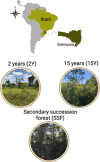Interaction between arbuscular mycorrhizal fungi and native soil microbiome on early stage restoration of a coal-mine soil
- PMID: 40778961
- PMCID: PMC12334516
- DOI: 10.1007/s00572-025-01218-3
Interaction between arbuscular mycorrhizal fungi and native soil microbiome on early stage restoration of a coal-mine soil
Abstract
The recovery of the soil ecosystem after severe disturbances, such as coal-mining activities, depends on both abiotic and biotic improvements. This study assessed the influence of arbuscular mycorrhizal (AM) fungal consortia on microbial community dynamics across two stages of soil recovery - 2 years (2Y) and 15 years (15Y) post-disturbance - using a secondary succession forest (SSR) as a reference. We analyzed bacterial community composition via 16 S rRNA gene amplicon sequencing and evaluated key soil quality indicators. While inoculation with AM fungal consortia had minimal effects on most soil parameters, significant differences were observed between recovery stages. The 15Y recovery site exhibited improved soil structure, microbial activity, and aggregate stability compared to the 2Y site, highlighting the importance of long-term restoration. However, potential overlap in ecological roles among native microorganisms likely mitigates the impact of AMF inoculation. These findings suggest that AM fungal consortia alone may not drive immediate improvements in soil quality but can contribute to microbial interactions and recovery processes over time. This study highlights the complexity of soil restoration and emphasizes the need for strategies that integrate plant cover with microbial community development to enhance long-term ecosystem stability. Further research should explore the specific roles of AM fungi and native soil microbes in promoting soil structure and accelerating recovery.
Keywords: AM fungal consortia; Combined inoculation; Glomeromycota; Microbiome; Simplified community.
© 2025. The Author(s).
Conflict of interest statement
Declarations. Competing interests: The authors declare no competing interests.
Figures






References
-
- Alvares CA, Stape JL, Sentelhas PC, Gonçalves JLM, Sparovek G (2013) Köppen’s climate classification map for Brazil. Meteorol Z 22:711–728. 10.1127/0941-2948/2013/0507
-
- Álvarez-Lopeztello A, Hernández-Cuevas LV, del Castillo RF, Robles C (2019) Diversity of arbuscular mycorrhizal fungi associated with Brachiaria brizantha pastures in lowlands of Oaxaca. Mexico Grassl Sci 65:197–201. 10.1111/grs.12224
-
- Anckaert A, Declerck S, Poussart LA, Lambert S, Helmus C, Boubsi F, Steels S, Arias AA, Salmon MC, Ongena M (2024) The biology and chemistry of a mutualism between a soil bacterium and a mycorrhizal fungus. Curr Biol 34:4934–4950. 10.1016/j.cub.2024.09.019 - PubMed
-
- Antunes PM, Stürmer SL, Bever JD, Chagnon PL, Chaudhary VB, Deveautour C, Fahey C, Kokkoris V, Lekberg Y, Powell JR, Aguilar-Trigueros CA, Zhang H (2025) Enhancing consistency in arbuscular mycorrhizal trait-based research to improve predictions of function. Mycorrhiza 35:1–25. 10.1007/s00572-025-01187-7 - PMC - PubMed
MeSH terms
Substances
Grants and funding
- CZ.02.01.01/00/22_008/0004597/Ministry of Education, Youth and Sports of the Czech Republic (grant Talking microbes - understanding microbial interactions within One Health framework)
- 24-12013S/Czech Science Foundation
- RVO 61388971/Czech Academy of Sciences
- 2016TR2257/Fundação de Amparo à Pesquisa e Inovação do Estado de Santa Catarina
- Process 307.995/2019-4/National Council for Scientific and Technological Development (CNPq)
LinkOut - more resources
Full Text Sources

